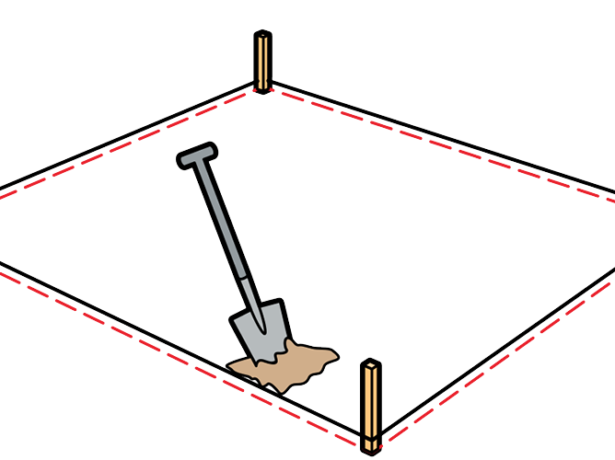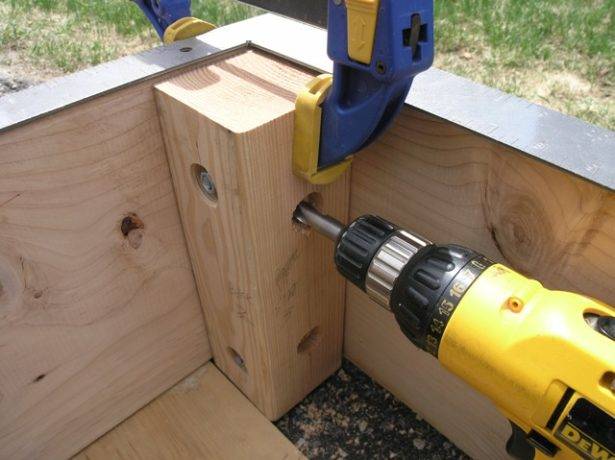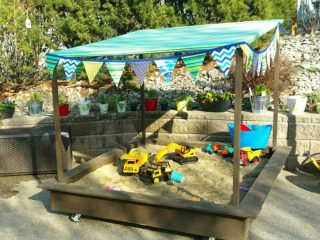Content
- 1 A variety of sandboxes with a lid
- 2 Where is the best place to install a children's sandbox with a lid?
- 3 Selecting material for assembling a children's sandbox with a transforming lid
- 4 We draw up a detailed diagram of a children's sandbox with a lid
- 5 The procedure for making a sandbox with a lid
- 6 Giving a children's sandbox an aesthetic appearance
Playing in the sandbox is a favorite pastime for all kids. As soon as our beloved child begins to walk independently, his mother buys him shovels and cake pans and takes him out to play in the yard. However, such summer fun can be spoiled by an unpleasant moment. Public sandboxes are not covered with anything, which makes them the object of attention for yard animals, where they set up a toilet. It is clear that it is difficult to solve this problem in playgrounds located among apartment buildings. But if children's entertainment is arranged in a private yard, then the best option would be a children's sandbox with a lid that protects the sand from uninvited guests.
A variety of sandboxes with a lid
Building children's sandboxes with a lid with your own hands is not that difficult. As a last resort, you can give preference to a store model. When making it yourself, the most popular is the wooden structure. Natural material lends itself well to processing. Usually the sandbox is made in a rectangular shape, and a shield is knocked down from boards as a lid.Parents who do not like to settle on standard solutions build a structure in the form of a car, a boat or a fairy-tale character. Even the lid for the sandbox is not easy to make. The shield is assembled from individual segments fastened with loops. When you open this lid, you get two comfortable benches with a back.
It’s quite easy for a child to organize a sandbox out of old tires. To do this, take one large tire, cut a strip on the side right up to the tread, and fill the resulting box with sand. Small tires make sandboxes in the shape of flowers or other unusual shapes. To make them, tires are cut into two or three segments, after which they are sewn together with wire, sometimes bolted together. The lid for such sandboxes is usually a tarpaulin.
A store-bought plastic sandbox attracts children with its bright colors. There are solid bowls and collapsible designs of different sizes. The first type of sandboxes is usually made in the form of animals and other fauna. For example, a product in the shape of a turtle or ladybug is very convenient to use. The lower part of the body serves as a container for sand, and the shell makes an excellent cover. Collapsible sandboxes consist of separate modules, which allows you to assemble a box of the desired size and shape. Typically, such structures are sold without a bottom and a lid, but can be equipped with a tarpaulin.
Where is the best place to install a children's sandbox with a lid?
Just because a sandbox has a lid, even a roof, does not mean it can be installed anywhere in the yard. A playground made in the yard should be located in a place that is clearly visible, but not very windy. Otherwise, sand will constantly fly into the child’s eyes. It is optimal to position a children's sandbox with a transforming lid so that part of it is illuminated by the sun, and the other half is shaded. Such a place happens near a spreading tree or a tall building. If a children's sandbox with a lid can only be installed in a sunny area, you will have to take care of constructing a canopy.
Selecting material for assembling a children's sandbox with a transforming lid
Today we will look at how to make a sandbox with a bench lid with our own hands, look at the photo of the drawing of important components, but first we will talk about choosing suitable materials.
Let's start with the box and lid. You won’t be able to make a similar design for children out of plastic yourself. There are options made from PET bottles, old plastic window sills and other rubbish, but a child is unlikely to like such a sandbox. As for tires, this is a good option. However, it will not be possible to organize normal benches with a back that transform into a lid due to the irregular shape of the sandbox. You need a rectangular box, and it would be better to make it from a board. Ideal for price and quality, the blanks are made from pine. Boards made of oak or larch will last longer, but their cost is higher, and hard wood is more difficult to process.
When building a children's sandbox with a lid, you will need a piece of moisture-resistant but porous material. Agrofibre or geotextiles are suitable for these purposes. The material separates the soil from the sand, preventing them from mixing. The porous structure will allow moisture into the soil. Thanks to the material they will not grow in the middle of the sand weeds, and earthworms will not crawl out of the ground.
It is important to pay attention to the quality of the filler. The ideal option is sand sold in stores. It went through several stages of cleaning and processing, right down to grinding the sharp corners of the grains of sand. This filler is ideal for plastic sandboxes, as it does not scratch the walls of the box. When purchasing sand, it is advisable to look at documents indicating the origin of the goods. It's better to open the bag and feel the contents. High-quality sand is characterized by excellent flowability, has one shade and does not stick to dry palms.
A do-it-yourself children's sandbox made from boards in a suburban area is usually filled with quarry or river sand. It is first sifted to remove stones and various debris. If the sand contains a lot of dust, it will constantly stick to the child’s hands and stain his clothes. Before use, this filler must be rinsed with water and then dried thoroughly.
We draw up a detailed diagram of a children's sandbox with a lid
The design of a sandbox with a lid is not so complicated that a detailed project needs to be developed during its construction. Craftsmen often adjust the dimensions of all workpieces during the assembly process.It will be difficult for a parent building a children's structure for the first time, so for reference, we suggest looking at the drawings of the box and the folding lid of the bench.
First, in the photo, let’s look at the diagram of the sandbox itself. Let's take the classic version measuring 1.5 x 1.5 m as a basis. This sandbox is enough for three children to play. It is optimal to make the height of the sides of the box about 30 cm. It can be a little higher or lower, the main thing is that the child can easily step over the fence.
When determining the height of the sides, it is important to remember that the lid of the children's sandbox will fold out into two benches. An optimal distance is provided between the seat and the filler so that the child can hang his legs comfortably.
Next, let's look at the lid of the children's sandbox, which folds out into two benches. The photo shows a diagram of the structure in unfolded form. The lid consists of two halves, each of which has three independent elements. The dimensions are selected exclusively for a box with dimensions of 1.5x1.5 m.
In the photo the number 4 indicates the box. We know its size. The number 3 indicates the seat of a bench with a width of 17.5 cm. There are two such elements on the bench. The back of the bench, which is the third module of the folding lid, is designated by the number 5. Its width is 40 cm. The numbers 2 and 6 indicate the back rests, the latter additionally playing the role of handrails. The number 1 indicates the hinges connecting the folding modules. The element numbered 3 is stationary and is permanently fixed to the sides of the box.
The procedure for making a sandbox with a lid
Now, to visually familiarize yourself with the manufacture of a children's sandbox, instructions will be offered with the step-by-step assembly of all elements. All actions are accompanied by photos with a description of the work being carried out.
So, armed with the tool, let’s start building a children’s sandbox with a folding lid:
- Markings are applied to the selected area for the construction of a children's sandbox. Since the box has a square shape, it is better to determine the boundaries of the structure by driving stakes into the ground. It is enough to place four of them in the corners, and stretch the cord between them. Using a tape measure or regular non-stretch rope, measure equal diagonals between opposite corners to create an even square.
- Using a bayonet and shovel shovel, remove the turf layer of soil in the marked area. You should get a square depression of up to 30 cm. Removing the turf will prevent the growth of weeds under the bottom of the children's sandbox, as well as rotting of the remaining grass.
- The bottom of the dug hole is leveled with a rake. Loose soil is lightly compacted. Next, make a mixture of sand with gravel or small crushed stone, after which it is poured onto the bottom of the pit with a thickness of 10 cm. Thanks to the drainage layer, rainwater that accidentally falls from the sand will be absorbed into the soil. This can happen through a lid that you forgot to close. A similar pillow 50 cm wide can be made around the sandbox. Then after the rain there will be no puddles around the box.
- Eight holes are dug along the perimeter of the pit. Four of them are located at the corners, and another four are located in the center of the sides. The box supports will be installed here. Holes are dug up to 40 cm deep and 15 cm in diameter. The bottom of the holes is covered with a similar mixture of sand and gravel 5 cm thick.
- Making a children's sandbox begins with preparing the bottom of the pit. Previously, it was already covered with a drainage layer, now it needs to be covered with geotextiles or dense agrofibre. Sometimes for these purposes a black film is used, perforated with a nail for drainage. You can do this, but it's not the best option. Moisture will be retained in depressions without holes, causing mold to appear.
- The box of the children's sandbox is made from edged boards. But before this, all workpieces are carefully processed with sandpaper or a grinder. To fasten the boards together, you will need eight bars with a cross-section of 5x5 cm and a length of 70 cm. These will form supports at the corners of the box and the center of the sides. The length of the bars was chosen on the basis that 30 cm will be used to connect the fence boards, and 40 cm will go into the dug holes.
- You can connect boards to bars using nails, screws or bolts. When using the latest hardware, you must make sure that there are no protruding nuts and bolt heads on the surface. For this purpose, hardware is selected with a length slightly less than the thickness of the workpieces to be joined. Using a thin drill, through the diameter of the threaded part of the bolt, drill through holes. Then, take a drill slightly thicker than the diameter of the nut and hardware head and drill small recesses in the finished holes. The result is a bolted connection hidden in the wood.
- The final result should be a structure with eight legs, as in this photo. At this stage, the wood is treated with an antiseptic, and the protruding supports are treated with bitumen mastic.
- The box is ready, now we start making the bench, which when folded will act as a lid for a children's sandbox. So, we take a board 17.5 cm wide.Its length should be a couple of centimeters greater than the width of the box so that the lid can completely cover the sandbox. The board is fixed flat with self-tapping screws to the end of the side of one of the sides of the box. In this example, for convenience, we consider the process of making one bench. Exactly the same design is made on the opposite side of the box. The result is a lid made of two folding halves.
- Two hinges are attached to the fixed board on top with self-tapping screws. In this case, approximately 30 cm retreat from the edge of the workpiece.
- At the next stage, take a board of similar sizes. It is screwed to the hinges with self-tapping screws. The result was the first folding element of the bench. Now two more loops are attached to it, only from below.
- Now it's time for the back of the bench. A board 40 cm wide is fixed to the hinges. The result is a bench made of three boards connected by hinges on the outside and inside.
- Two limiters are attached from slats to the back of the bench back. When the lids are unfolded, they will rest on the side of the children's sandbox. Two more limiters are attached to the base of the seat. They will prevent the back from falling forward, plus they will act as handrails.
When the benches are ready on both sides of the box, the children's sandbox is installed in its place. To do this, the racks are lowered into the prepared holes, after which they are compacted tightly with soil. The holes can be concreted, but in the future it will be difficult to remove the children's sandbox from the ground.
The video demonstrates the making of a bench cover on a children's sandbox:
Giving a children's sandbox an aesthetic appearance
So, we looked at how to make a sandbox with a folding lid with your own hands. The design is ready, now it needs to be brought to fruition. The entire surface of the children's sandbox with a lid is checked for the presence of burrs.This is especially true for benches and the ends of the box. If sharp corners are identified, additional grinding is performed, then these areas are once again treated with an antiseptic.
To give a children's sandbox with a lid an aesthetic appearance and protect the wood from moisture, the structure is painted with oil or acrylic paint. It is advisable to give preference to bright colors to attract the child's attention.























